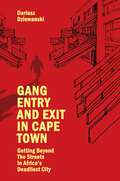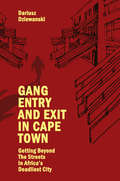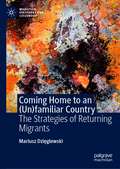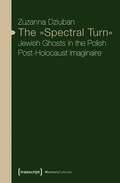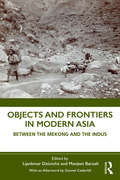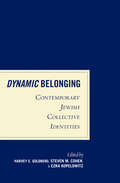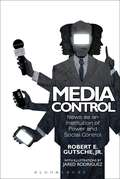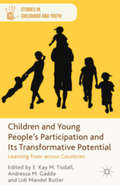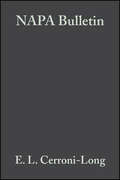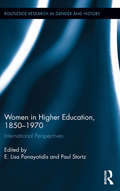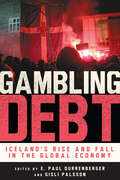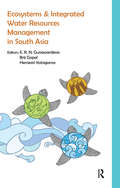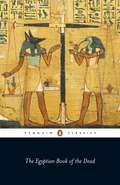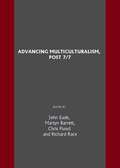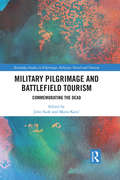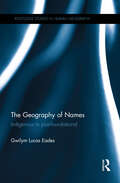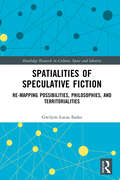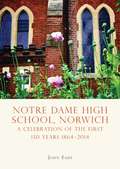- Table View
- List View
Gang Entry and Exit in Cape Town: Getting Beyond The Streets in Africa’s Deadliest City
by Dariusz DziewanskiGang violence is a concern being debated by academics, politicians, and communities around the world. Yet effective solutions are still in short supply, partly because too little research concentrates on understanding how people can escape the trap of violent street culture. Responding to that need, this book provides a detailed qualitative account of what it is like to join and then disengage from gangs in Africa’s deadliest city. Through the life histories of twenty-four former Capetonian gang members, alongside hundreds of hours of additional interviews and observation from five years of ethnographic research, Dariusz Dziewanski reimagines gangsterism in a way that pays heed to the overwhelming force of street culture, but also confirms the possibility of overcoming crime and violence amid disenfranchisement and disadvantage. Rather than simply reproducing the poverty-crime-violence narrative, this book demonstrates how gang members can – and have – transformed their lives, challenging the pessimistic conclusions commonly associated with gang entry; even gang scholars studying street culture usually portray the end point to gang life as either prison or a body bag. By presenting evidence about successful gang exit, Dziewanski showcases a practical starting point for changing how criminologists think about gangs and street culture – offering hope to those trying exit gang life, as well as those trying to help them do so
Gang Entry and Exit in Cape Town: Getting Beyond The Streets in Africa’s Deadliest City
by Dariusz DziewanskiGang violence is a concern being debated by academics, politicians, and communities around the world. Yet effective solutions are still in short supply, partly because too little research concentrates on understanding how people can escape the trap of violent street culture. Responding to that need, this book provides a detailed qualitative account of what it is like to join and then disengage from gangs in Africa’s deadliest city. Through the life histories of twenty-four former Capetonian gang members, alongside hundreds of hours of additional interviews and observation from five years of ethnographic research, Dariusz Dziewanski reimagines gangsterism in a way that pays heed to the overwhelming force of street culture, but also confirms the possibility of overcoming crime and violence amid disenfranchisement and disadvantage. Rather than simply reproducing the poverty-crime-violence narrative, this book demonstrates how gang members can – and have – transformed their lives, challenging the pessimistic conclusions commonly associated with gang entry; even gang scholars studying street culture usually portray the end point to gang life as either prison or a body bag. By presenting evidence about successful gang exit, Dziewanski showcases a practical starting point for changing how criminologists think about gangs and street culture – offering hope to those trying exit gang life, as well as those trying to help them do so
Coming Home to an: The Strategies of Returning Migrants (Migration, Diasporas and Citizenship)
by Mariusz DzięglewskiThis volume focuses on the process of return migration, from a holistic and policy-oriented perspective. Studies in return migration, which remains a vibrant field for academics, researchers, and policy-makers, have provided a large body of knowledge on particular issues, but generally fall along two lines: they are either broad macro analyses and models (especially economic ones) or narrow ethnographic views (anthropological, sociological, or psychological). This volume attempts to chart a course between these two approaches, combining returning migrants’ life trajectories, as seen by themselves, with analysis of the structural processes that have taken place in the last three decades in Europe and in Poland, as a new EU country. In analyzing the social and cultural changes reflected in the biographies of returning migrants, the author uses a framework based on an original synthesis of Alfred Schütz’s phenomenological approach, focusing on the returnees’ “life words,” with the social realism of Margaret Archer, focusing on the concerns and projects of individuals interacting with social and cultural structures.
The »Spectral Turn«: Jewish Ghosts in the Polish Post-Holocaust Imaginaire (Erinnerungskulturen / Memory Cultures #6)
by Zuzanna DziubanOver the last decades, studies on cultural memory have taken a »spectral turn« and have explored the potential of haunting metaphors for addressing past instances of violence that affect present cultural realities. This book contributes to the discussions on haunting by enquiring into its culturally and historically located modality: the emergence of the figure of the Jewish ghost in contemporary Polish popular culture, literature and critical art. Gathering contributions from an interdisciplinary group of scholars, it locates this new interest in Jewish ghosts on the map of other Polish (and Jewish) ghostologies and seeks to explore their cultural and political functions in the Polish post-Holocaust imaginaire.
Gelehrte Frauen der Frühaufklärung: Einsame ‚Wunderthiere‘ oder vernetzte Akteurinnen? (Frauen in Philosophie und Wissenschaft. Women Philosophers and Scientists)
by Corinna Dziudzia Sonja KlimekDieser Band versammelt die Beiträge einer Tagung, die im Februar 2019 mit Unterstützung des Forschungsverbunds Marbach Weimar Wolfenbüttel und der Dr. phil. Fritz Wiedemann Stiftung in der Herzog August Bibliothek in Wolfenbüttel stattfand. Ziel der interdisziplinären Veranstaltung war es, die Frühaufklärung als eine Zeitspanne sichtbar werden zu lassen, in der sich für Frauen, wenngleich teilweise nur vorübergehend, zahlreiche Tätigkeitsfelder eröffneten, sei dies als Ärztinnen, Malerinnen, Kupferstecherinnen oder Dichterinnen. Frauen führten in dieser Zeit europaweit gesellige, gelehrte und/oder musikalische Salons und betätigten sich als Mäzeninnen oder selbst als hochgeschätzte Musikerinnen und Komponistinnen. Universitäten, Akademien und Gesellschaften verliehen den gelehrten Frauen im 17. und 18. Jahrhundert Preise und sogar Doktorwürden. Darüber hinaus wurden Frauen in der Frühaufklärung als malende, kämpfende, rechnende, experimentierende, übersetzende und heilende Frauen aktiv.
Objects and Frontiers in Modern Asia: Between the Mekong and the Indus
by Lipokmar Dzüvichü Manjeet BaruahFocusing on the geographies between the Mekong and the Indus, this book brings objects to the centre of enquiry in the understanding of modern Asian frontiers. It explores how a range of objects have historically been significant bearers and agents of frontier making. For instance, how are objects connected to aspects of state making, social change, everyday life, diplomacy, political and ecological worlds, capital, forms of violence, resistances, circulations, and aesthetic expressions? This book seeks to interrogate and understand the dynamism of frontiers from the vantage point of objects such as salt, rubber, tea, guns, silk scarves, horses, and opium. It attempts to explore objects as sites of encounter, mediation, or dislocation between the social and the spatial. The book not only locates objects in the specificities of frontier spaces, but it also looks at how they are produced, circulated, and come to be intricately linked to a wide range of people, institutions, networks, and geographies. In the process, it explores how objects traverse and come to inhabit multiple historical, cultural, and geographical scales. This book will be of interest to researchers and academics working in areas of history, social and cultural anthropology, Asian studies, frontiers and borderland studies, cultural studies, political and economic studies, and museum studies.
Objects and Frontiers in Modern Asia: Between the Mekong and the Indus
by Lipokmar Dzüvichü Manjeet BaruahFocusing on the geographies between the Mekong and the Indus, this book brings objects to the centre of enquiry in the understanding of modern Asian frontiers. It explores how a range of objects have historically been significant bearers and agents of frontier making. For instance, how are objects connected to aspects of state making, social change, everyday life, diplomacy, political and ecological worlds, capital, forms of violence, resistances, circulations, and aesthetic expressions? This book seeks to interrogate and understand the dynamism of frontiers from the vantage point of objects such as salt, rubber, tea, guns, silk scarves, horses, and opium. It attempts to explore objects as sites of encounter, mediation, or dislocation between the social and the spatial. The book not only locates objects in the specificities of frontier spaces, but it also looks at how they are produced, circulated, and come to be intricately linked to a wide range of people, institutions, networks, and geographies. In the process, it explores how objects traverse and come to inhabit multiple historical, cultural, and geographical scales. This book will be of interest to researchers and academics working in areas of history, social and cultural anthropology, Asian studies, frontiers and borderland studies, cultural studies, political and economic studies, and museum studies.
Objects and Frontiers in Modern Asia: Between the Mekong and the Indus
by Lipokmar Dzüvichü Manjeet BaruahFocusing on the geographies between the Mekong and the Indus, this book brings objects to the centre of enquiry in the understanding of modern Asian frontiers. It explores how a range of objects have historically been significant bearers and agents of frontier making. For instance, how are objects connected to aspects of state making, social change, everyday life, diplomacy, political and ecological worlds, capital, forms of violence, resistances, circulations, and aesthetic expressions? This book seeks to interrogate and understand the dynamism of frontiers from the vantage point of objects such as salt, rubber, tea, guns, silk scarves, horses, and opium. It attempts to explore objects as sites of encounter, mediation, or dislocation between the social and the spatial. The book not only locates objects in the specificities of frontier spaces, but it also looks at how they are produced, circulated, and come to be intricately linked to a wide range of people, institutions, networks, and geographies. In the process, it explores how objects traverse and come to inhabit multiple historical, cultural, and geographical scales. This book will be of interest to researchers and academics working in areas of history, social and cultural anthropology, Asian studies, frontiers and borderland studies, cultural studies, political and economic studies, and museum studies.
Dynamic Belonging: Contemporary Jewish Collective Identities
by Harvey E. Steven M. Cohen Ezra KopelowitzWorld Jewry today is concentrated in the US and Israel, and while distinctive Judaic approaches and practices have evolved in each society, parallels also exist. This volume offers studies of substantive and creative aspects of Jewish belonging. While research in Israel on Judaism has stressed orthodox or “extreme” versions of religiosity, linked to institutional life and politics, moderate and less systematized expressions of Jewish belonging are overlooked. This volume explores the fluid and dynamic nature of identity building among Jews and the many issues that cut across different Jewish groupings. An important contribution to scholarship on contemporary Jewry, it reveals the often unrecognized dynamism in new forms of Jewish identification and affiliation in Israel and in the Diaspora.
Media Control: News as an Institution of Power and Social Control
by Robert E. Jr.Media Control: News as an Institution of Power and Social Control challenges traditional (and even some radical) perceptions of how the news works. While it's clear that journalists don't operate objectively – reporters don't just cover news, but they make it – Media Control goes a step further by arguing that the cultural institution of news approaches and presents everyday information from particular and dominant cultural positions that benefit the power elite. From analysing how the press operate as police agents by conducting surveillance and instituting social order through its coverage of crime and police action to bolstering private business and neoliberal principles by covering the news through notions of boosterism, Media Control presents the news through a cultural lens. Robert E. Gutsche, Jr. introduces or advances readers' applications of critical race theory and cultural studies scholarship to explore cultural meanings within news coverage of police action, the criminal justice system, and embedding into the news democratic values that are later used by the power elite to oppress and repress portions of the citizenry. Media Control helps the reader explicate how the power elite use the press and the veil of the Fourth Estate to further white ideologies and American Imperialism.
Media Control: News as an Institution of Power and Social Control (University Casebook Ser.)
by Robert E. Jr.Media Control: News as an Institution of Power and Social Control challenges traditional (and even some radical) perceptions of how the news works. While it's clear that journalists don't operate objectively – reporters don't just cover news, but they make it – Media Control goes a step further by arguing that the cultural institution of news approaches and presents everyday information from particular and dominant cultural positions that benefit the power elite. From analysing how the press operate as police agents by conducting surveillance and instituting social order through its coverage of crime and police action to bolstering private business and neoliberal principles by covering the news through notions of boosterism, Media Control presents the news through a cultural lens. Robert E. Gutsche, Jr. introduces or advances readers' applications of critical race theory and cultural studies scholarship to explore cultural meanings within news coverage of police action, the criminal justice system, and embedding into the news democratic values that are later used by the power elite to oppress and repress portions of the citizenry. Media Control helps the reader explicate how the power elite use the press and the veil of the Fourth Estate to further white ideologies and American Imperialism.
Children and Young People's Participation and Its Transformative Potential: Learning from across Countries (Studies in Childhood and Youth)
by E. Kay M. TisdallBringing together theories, ideas, insights and experiences of practitioners and researchers from Brazil, India, South Africa and the UK, this book explores children and young people's involvement in public action. The contributors consider the potential of children and young people's participation to be transformative.
Insider Anthropology
by E. L. Cerroni-LongNAPA Bulletin is a peer reviewed occasional publication of the National Association for the Practice of Anthropology, dedicated to the practical problem-solving and policy applications of anthropological knowledge and methods. peer reviewed publication of the National Association for the Practice of Anthropology dedicated to the practical problem-solving and policy applications of anthropological knowledge and methods most editions available for course adoption
Women in Higher Education, 1850-1970: International Perspectives (Routledge Research in Gender and History)
by E. Lisa Panayotidis and Paul StortzThis edited collection illustrates the way in which women’s experiences of academe could be both contextually diverse but historically and culturally similar. It looks at both the micro (individual women and universities) and macro-level (comparative analyses among regions and countries) within regional, national, trans-national, and international contexts. The contributors integrally advance knowledge about the university in history by exploring the intersections of the lived experiences of women students and professors, practices of co-education, and intellectual and academic cultures. They also raise important questions about the complementary and multidirectional flow and exchange of academic knowledge and information among gender groups across programmes, disciplines, and universities. Historical inquiry and interpretation serve as efficacious ways with which to understand contemporary events and discourses in higher education, and more broadly in community and society. This book will provide important historical contexts for current debates about the numerical dominance and significance of women in higher education, and the tensions embedded in the gendering of specific academic programs and disciplines, and university policies, missions, and mandates.
Gambling Debt: Iceland's Rise and Fall in the Global Economy
by E. Paul Durrenberger and Gisli PalssonGambling Debt is a game-changing contribution to the discussion of economic crises and neoliberal financial systems and strategies. Iceland’s 2008 financial collapse was the first case in a series of meltdowns, a warning of danger in the global order. This full-scale anthropology of financialization and the economic crisis broadly discusses this momentous bubble and burst and places it in theoretical, anthropological, and global historical context through descriptions of the complex developments leading to it and the larger social and cultural implications and consequences. Chapters from anthropologists, sociologists, historians, economists, and key local participants focus on the neoliberal policies—mainly the privatization of banks and fishery resources—that concentrated wealth among a select few, skewed the distribution of capital in a way that Iceland had never experienced before, and plunged the country into a full-scale economic crisis. Gambling Debt significantly raises the level of understanding and debate on the issues relevant to financial crises, painting a portrait of the meltdown from many points of view—from bankers to schoolchildren, from fishers in coastal villages to the urban poor and immigrants, and from artists to philosophers and other intellectuals. This book is for anyone interested in financial troubles and neoliberal politics as well as students and scholars of anthropology, sociology, economics, philosophy, political science, business, and ethics. Publication supported in part by the National Science Foundation. Contributors: Vilhjálmur Árnason, Ásmundur Ásmundsson, Jón Gunnar Bernburg, James Carrier, Sigurlína Davíðsdóttir, Dimitra Doukas, Níels Einarsson, Einar Mar Guðmundsson, Tinna Grétarsdóttir, Birna Gunnlaugsdóttir, Guðný S. Guðbjörnsdóttir, Pamela Joan Innes, Guðni Th. Jóhannesson, Örn D. Jónsson, Hannes Lárusson, Kristín Loftsdóttir, James Maguire, Már Wolfgang Mixa, Evelyn Pinkerton, Hulda Proppé, James G. Rice, Rögnvaldur J. Sæmundsson, Unnur Dís Skaptadóttir, Margaret Willson
Ecosystems and Integrated Water Resources Management in South Asia
by E. R. N. Gunawardena; Brij Gopal; Hemesiri KotagamaThis book provides an ecosystem perspective in addressing the water resource management issues in the South Asian region. It argues that aspects such as sources of water, its distribution and users; land–water interrelations; drivers of change such as laws, policies and institutions; management of issues and technologies related to water supply; institutional set-up; economic instruments such as pricing, taxes, subsidies; and economics of ecosystem services are crucial. Climate changes, melting of glaciers and polar ice caps, rising sea level and the increased frequency of extreme events, have to be factored into integrated management of water resources. This book addresses some of these major issues related to aquatic ecosystems and focuses on three major aspects: (a) concepts related to ecosystems, ecosystem services and their linkages with water; (b) human impacts on ecosystems, particularly the aquatic ecosystems, and their assessment; and (c) the management, including policy, governance and economics. Comprising new theories, research and case studies, the book will be useful those concerned with water resource management – professionals, students and researchers.
The Egyptian Book of the Dead: The Papyrus Of Ani (Mini Albums Ser.)
by E.A. Wallis Budge John RomerThe Book of the Dead is a unique collection of funerary texts from a wide variety of sources, dating from the fifteenth to the fourth century BC. Consisting of spells, prayers and incantations, each section contains the words of power to overcome obstacles in the afterlife. The papyruses were often left in sarcophagi for the dead to use as passports on their journey from burial, and were full of advice about the ferrymen, gods and kings they would meet on the way. Offering valuable insights into ancient Egypt, The Book of the Dead has also inspired fascination with the occult and the afterlife in recent years.
Advancing Multiculturalism, Post 7/7
by John EadeMulticulturalism still matters and is even more important after 7/7 than it was before. The political discourse and rhetoric of integration sits uncomfortably alongside both multicultural realities e.g. the civil disturbances in Birmingham, England (October 2005), Paris, France (November 2005) and Sydney, Australia (December, 2005) and social scientific notions of where multiculturalism positions itself domestically and internationally. This edited collection is intended to be a major contribution to studies of multiculturalism examining the historical background and anthropological context, alongside more contemporary applied social policy perspectives. In this volume, we argue that a multicultural perspective is as relevant and important, both socially and politically in a post 7/7 world. Within a post 7/7 context, there are contributors within this edited collection who argue for both integrationist and multicultural approaches. The volume acknowledges both concepts and encourages the reader to increase understandings of both arguments and position her / himself within the debates.
Military Pilgrimage and Battlefield Tourism: Commemorating the Dead (Routledge Studies in Pilgrimage, Religious Travel and Tourism)
by John Eade Mario Kati 263Military Pilgrimage and Battlefield Tourism is the first volume to bring together a detailed analysis of professional military pilgrimage with other forms of commemorating military conflict. The volume looks beyond the discussion of battlefield tourism undertaken primarily by civilians which has dominated research until now through an analysis of the relationship between religious, military and civilian participants. Drawing on a comparative approach towards what has mostly been categorised as secular pilgrimage, dark tourism/thanatourism, military and religious tourism, and re-enactment, the contributors explore the varied ways in which memory, material culture and rituals are performed at particular places. The volume also engages with the debate about the extent to which western definitions of pilgrimage and tourism, as well as such related terms as religion, sacred and secular, can be applied in non-western contexts.
Military Pilgrimage and Battlefield Tourism: Commemorating the Dead (Routledge Studies in Pilgrimage, Religious Travel and Tourism)
by John Eade Mario Kati 263Military Pilgrimage and Battlefield Tourism is the first volume to bring together a detailed analysis of professional military pilgrimage with other forms of commemorating military conflict. The volume looks beyond the discussion of battlefield tourism undertaken primarily by civilians which has dominated research until now through an analysis of the relationship between religious, military and civilian participants. Drawing on a comparative approach towards what has mostly been categorised as secular pilgrimage, dark tourism/thanatourism, military and religious tourism, and re-enactment, the contributors explore the varied ways in which memory, material culture and rituals are performed at particular places. The volume also engages with the debate about the extent to which western definitions of pilgrimage and tourism, as well as such related terms as religion, sacred and secular, can be applied in non-western contexts.
The Geography of Names: Indigenous to post-foundational (Routledge Studies in Human Geography)
by Gwilym Lucas EadesThis book examines geographical names, place-names, and toponymy from philosophical and cultural evolutionary perspectives. Geographical name-tracking-networks (Geo-NTNs) are posited as tools for tracking names through time and across space, and for making sense of how names evolve both temporally and spatially. Examples from North and South American indigenous groups, the Canadian arctic, Wales, England, and the Middle East are brought into a theoretical framework for making sense of aspects of place-naming practices, beliefs, and systems. New geographical tools such as geographic information systems (GIS) and global positioning systems (GPS) are demonstrated to be important in the production and maintenance of robust networks for keeping names and their associated meanings viable in a rapidly changing world where place-naming is being taken up increasingly in social media and other new mapping platforms. The Geography of Names makes the case that geographical names are transmitted memetically (i.e. as cultural units, or memes) through what Saul Kripke called communication chains. Combining insights from Kripke with views of later Wittgenstein on language and names as being inherently spatial, the present work advances theories of both these thinkers into an explicitly geographical inquiry that advances philosophical and practical aspects of naming, language, and mapping.
The Geography of Names: Indigenous to post-foundational (Routledge Studies in Human Geography)
by Gwilym Lucas EadesThis book examines geographical names, place-names, and toponymy from philosophical and cultural evolutionary perspectives. Geographical name-tracking-networks (Geo-NTNs) are posited as tools for tracking names through time and across space, and for making sense of how names evolve both temporally and spatially. Examples from North and South American indigenous groups, the Canadian arctic, Wales, England, and the Middle East are brought into a theoretical framework for making sense of aspects of place-naming practices, beliefs, and systems. New geographical tools such as geographic information systems (GIS) and global positioning systems (GPS) are demonstrated to be important in the production and maintenance of robust networks for keeping names and their associated meanings viable in a rapidly changing world where place-naming is being taken up increasingly in social media and other new mapping platforms. The Geography of Names makes the case that geographical names are transmitted memetically (i.e. as cultural units, or memes) through what Saul Kripke called communication chains. Combining insights from Kripke with views of later Wittgenstein on language and names as being inherently spatial, the present work advances theories of both these thinkers into an explicitly geographical inquiry that advances philosophical and practical aspects of naming, language, and mapping.
Spatialities of Speculative Fiction: Re-Mapping Possibilities, Philosophies, and Territorialities (Routledge Research in Culture, Space and Identity)
by Gwilym Lucas EadesThis book examines science fiction, fantasy and horror novels utilizing a conceptual toolkit of the ten duties of speculative fiction. Building on previous work in the discipline of geography it will demonstrate the value of speculation in the visualisation of Anthropocene futures. The book presents insights into how novels produce specifically geographical knowledge about the world - spatialities - and how they use both literal maps and figurative counter-mappings to comment upon and shape futures. This book is about much more than science fiction. It covers areas of literature and para-literature associated with the "fantastic" and as such, looks also at works of fantasy and horror. The areas of overlap between these three categories of fantastic literature are posited as the most productive in the terms by which this book navigates, namely, spatiality. The book will explore, through the critical examination of a selection of key works of speculative fiction, how science-fictional and fantastic narratives are spatialized through both conceptual and literal mappings. This book is intended for both an academic and practitioner and for people interested in both producing scholarly commentary upon works of speculative fiction; and for those writing speculative fiction and novels.
Spatialities of Speculative Fiction: Re-Mapping Possibilities, Philosophies, and Territorialities (Routledge Research in Culture, Space and Identity)
by Gwilym Lucas EadesThis book examines science fiction, fantasy and horror novels utilizing a conceptual toolkit of the ten duties of speculative fiction. Building on previous work in the discipline of geography it will demonstrate the value of speculation in the visualisation of Anthropocene futures. The book presents insights into how novels produce specifically geographical knowledge about the world - spatialities - and how they use both literal maps and figurative counter-mappings to comment upon and shape futures. This book is about much more than science fiction. It covers areas of literature and para-literature associated with the "fantastic" and as such, looks also at works of fantasy and horror. The areas of overlap between these three categories of fantastic literature are posited as the most productive in the terms by which this book navigates, namely, spatiality. The book will explore, through the critical examination of a selection of key works of speculative fiction, how science-fictional and fantastic narratives are spatialized through both conceptual and literal mappings. This book is intended for both an academic and practitioner and for people interested in both producing scholarly commentary upon works of speculative fiction; and for those writing speculative fiction and novels.
Notre Dame High School, Norwich: A celebration of the first 150 years 1864–2014
by John EadyFor a century and a half Notre Dame High School has occupied a central position in Norwich, and within the Roman Catholic community of East Anglia. This book traces the school's founding, the development of the school site, its transition from a Catholic convent with a day and boarding school to a direct grant girls' grammar school, through to its becoming a mixed comprehensive and today's academy. Drawing on the school's archive, and the memories and experiences of past and present pupils and staff, a vivid picture emerges of an energetic and progressive school that continues to build on the values of its founding Sisters. This book will appeal to all members of the Notre Dame community, and to anyone with a passing interest in education and the history of Catholicism in East Anglia.
